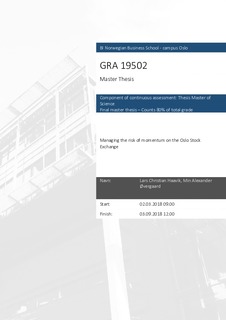Managing the risk of momentum on the Oslo Stock Exchange
Master thesis

Permanent lenke
http://hdl.handle.net/11250/2579784Utgivelsesdato
2018Metadata
Vis full innførselSamlinger
- Master of Science [1621]
Sammendrag
The concept of managing the risk of momentum trading has rendered the
notion of momentum portfolios more appealing to investors, as it addresses the
potential for devastating losses in the aftermath of periods of financial distress.
While this has been well researched on larger stock exchanges, smaller ones
have thus far been largely ignored. We examine the performance of the riskmanaged
momentum strategy as developed by Barroso & Santa-Clara (2015)
on the Norwegian market. This involves using an estimate of momentum risk
to scale exposure to the strategy, targeting constant risk over time. Maintaining
constant volatility when conducting a long-short strategy reflects what real
investors and hedge funds attempt to do, as opposed to maintaining constant
amounts invested in the long and short legs (Barroso & Santa-Clara, 2015).
Implicit in our research is a contribution to the contested hypothesis regarding
the relative profitability of momentum strategies in markets with varying
degrees of liquidity. We find that although managing the risk successfully
ïmproves the momentum strategy’s statistical properties as promised, the
momentum effect in Norway is very weak. Another caveat is that the highly
predictable risk of momentum that Barroso & Santa-Clara (2015) identified on
the larger stock exchanges is considerably less so on the Oslo Stock Exchange,
making the strategy more difficult to implement in Norway based on ex ante
information.
Beskrivelse
Masteroppgave(MSc) in Master of Science in Finance - Handelshøyskolen BI, 2018